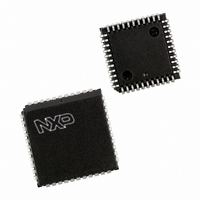P89C662HBA/00,512 NXP Semiconductors, P89C662HBA/00,512 Datasheet - Page 18

P89C662HBA/00,512
Manufacturer Part Number
P89C662HBA/00,512
Description
IC 80C51 MCU FLASH 32K 44-PLCC
Manufacturer
NXP Semiconductors
Series
89Cr
Datasheet
1.P89C660HBA00512.pdf
(89 pages)
Specifications of P89C662HBA/00,512
Core Processor
8051
Core Size
8-Bit
Speed
33MHz
Connectivity
I²C, UART/USART
Peripherals
POR, PWM, WDT
Number Of I /o
32
Program Memory Size
32KB (32K x 8)
Program Memory Type
FLASH
Ram Size
1K x 8
Voltage - Supply (vcc/vdd)
4.5 V ~ 5.5 V
Oscillator Type
Internal
Operating Temperature
0°C ~ 70°C
Package / Case
44-PLCC
Lead Free Status / RoHS Status
Lead free / RoHS Compliant
Eeprom Size
-
Data Converters
-
Other names
568-1269-5
935267444512
P89C662HBA
935267444512
P89C662HBA
Available stocks
Company
Part Number
Manufacturer
Quantity
Price
Company:
Part Number:
P89C662HBA/00,512
Manufacturer:
NXP Semiconductors
Quantity:
10 000
Philips Semiconductors
If the STA and STO bits are both set, the a STOP condition is
transmitted to the I
mode, SIO1 generates an internal STOP condition which is not
transmitted). SIO1 then transmits a START condition.
STO = “0”: When the STO bit is reset, no STOP condition will be
generated.
The Serial Interrupt Flag, SI: SI = “1”: When the SI flag is set, then,
if the EA and ES1 (interrupt enable register) bits are also set, a
serial interrupt is requested. SI is set by hardware when one of 25 of
the 26 possible SIO1 states is entered. The only state that does not
cause SI to be set is state F8H, which indicates that no relevant
state information is available.
While SI is set, the low period of the serial clock on the SCL line is
stretched, and the serial transfer is suspended. A high level on the
SCL line is unaffected by the serial interrupt flag. SI must be reset
by software.
SI = “0”: When the SI flag is reset, no serial interrupt is requested,
and there is no stretching of the serial clock on the SCL line.
The Assert Acknowledge Flag, AA: AA = “1”: If the AA flag is set,
an acknowledge (low level to SDA) will be returned during the
acknowledge clock pulse on the SCL line when:
– The “own slave address” has been received
– The general call address has been received while the general call
– A data byte has been received while SIO1 is in the Master
– A data byte has been received while SIO1 is in the addressed
AA = “0”: if the AA flag is reset, a not acknowledge (high level to
SDA) will be returned during the acknowledge clock pulse on SCL
when:
– A data has been received while SIO1 is in the Master Receiver
– A data byte has been received while SIO1 is in the addressed
When SIO1 is in the addressed Slave Transmitter mode, state C8H
will be entered after the last serial is transmitted (see Figure 11).
2002 Oct 28
bit (GC) in S1ADR is set
Receiver mode
Slave Receiver mode
mode
Slave Receiver mode
80C51 8-bit Flash microcontroller family
16KB/32KB/64KB ISP/IAP Flash with 512B/1KB/2KB/8KB RAM
2
C bus if SIO1 is in a Master mode (in a Slave
18
The frequencies shown in Table 3 are unimportant when SIO1 is in a
contains F8H, no relevant state information is available and no serial
When SI is cleared, SIO1 leaves state C8H, enters the not
addressed Slave Receiver mode, and the SDA line remains at a
high level. In state C8H, the AA flag can be set again for future
address recognition.
When SIO1 is in the not addressed Slave mode, its own slave
address and the general call address are ignored. Consequently, no
acknowledge is returned, and a serial interrupt is not requested.
Thus, SIO1 can be temporarily released from the I
bus status is monitored. While SIO1 is released from the bus,
START and STOP conditions are detected, and serial data is shifted
in. Address recognition can be resumed at any time by setting the
AA flag. If the AA flag is set when the part’s own Slave address or
the general call address has been partly received, the address will
be recognized at the end of the byte transmission.
The Clock Rate Bits CR0, CR1, and CR2: These three bits
determine the serial clock frequency when SIO1 is in a Master
mode. The various serial rates are shown in Table 3.
A 12.5 kHz bit rate may be used by devices that interface to the I
bus via standard I/O port lines which are software driven and slow.
100 kHz is usually the maximum bit rate and can be derived from a
16 MHz, 12 MHz, or a 6 MHz oscillator. A variable bit rate (0.5 kHz
to 62.5 kHz) may also be used if Timer 1 is not required for any
other purpose while SIO1 is in a Master mode.
Slave mode. In the Slave modes, SIO1 will automatically
synchronize with any clock frequency up to 100 kHz.
The Status Register, S1STA
S1STA is an 8-bit read-only special function register. The three least
significant bits are always zero. The five most significant bits contain
the status code. There are 26 possible status codes. When S1STA
interrupt is requested. All other S1STA values correspond to defined
SIO1 states. When each of these states is entered, a serial interrupt
is requested (SI = “1”). A valid status code is present in S1STA one
machine cycle after SI is set by hardware and is still present one
machine cycle after SI has been reset by software.
P89C660/P89C662/P89C664/
P89C668
2
C bus while the
Product data
2
C
















